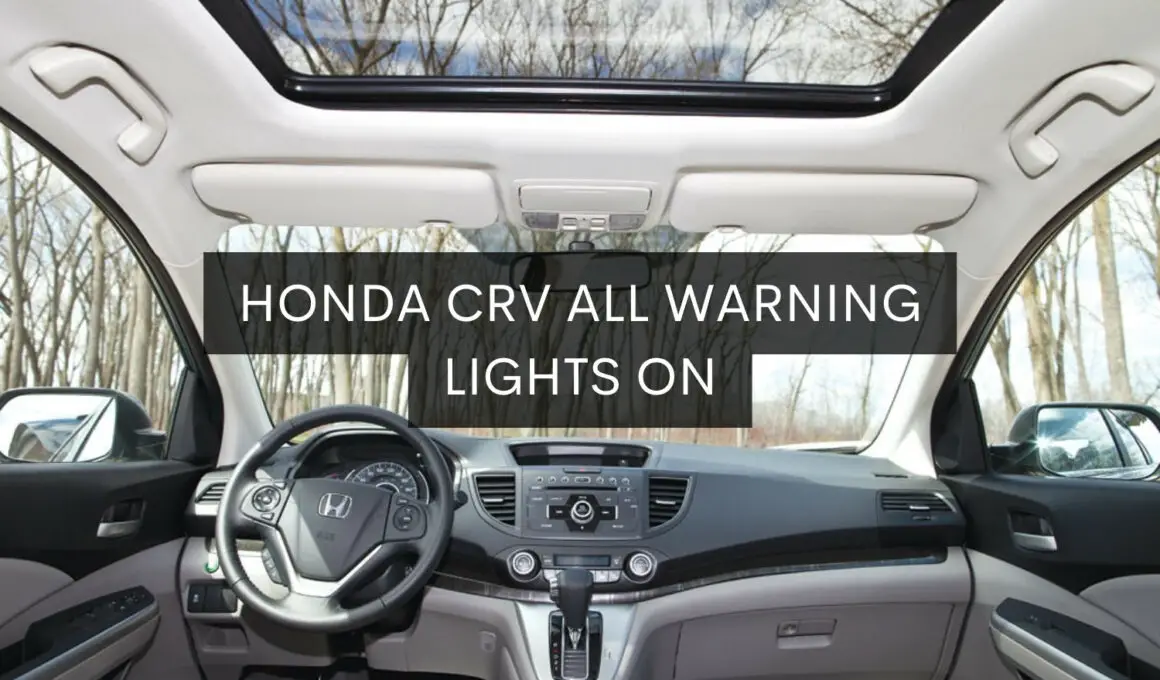In This Article Show
Over the years, the Honda CRV has firmly established itself as a reliable and popular choice among drivers worldwide. As an experienced mechanic with over 15 years of hands-on experience, I’ve worked with countless Honda CRVs, understanding their intricacies and resolving the issues they occasionally present.
One such issue that has troubled many Honda CRV owners is the unexpected illumination of all warning lights. Warning lights are designed to alert you to potential problems within your vehicle.
While they might seem daunting, especially when they all light up simultaneously, they’re your car’s way of communicating with you. In this comprehensive guide, we’ll discuss the causes behind this issue in Honda CRVs, and, more importantly, the practical fixes you can apply.
Let’s get started.
Understanding Warning Lights on Your Honda CRV
Warning lights on your Honda CRV serve a critical role – they’re like your car’s language to communicate with you. When something is amiss, these lights say, “Hey, something isn’t right here.”
Each warning light corresponds to a different system within your car. From engine issues to tire pressure, brake systems to oil levels, these lights are coded to specific potential problems. That’s why paying close attention to these warning lights is essential.
Ignoring them could result in minor issues escalating into significant problems, or worse, a breakdown.
However, there are instances when all warning lights on your Honda CRV may come on simultaneously. This can be quite alarming and is often a sign that something more systemic is going wrong.
A Detailed Look Into The Causes for All Warning Lights On in Honda CRV
Here are some of the reasons that might result in all warning lights being on in your Honda CRV;

1. Electrical System Issues
The electrical system of your Honda CRV is a complex network connecting different parts of your vehicle. It ensures systems like your headlights, radio, and dashboard lights function correctly.
An issue within this system—perhaps a blown fuse, a faulty relay, or a more complex problem—can lead to a failure in the communication between the vehicle’s components, causing all the warning lights to light up.
2. Malfunctioning Sensors
Your car is equipped with numerous sensors monitoring everything from oil pressure to engine temperature. If these sensors malfunction—possibly due to wear and tear, electrical problems, or even dirt and grime—they may send incorrect signals to the car’s computer, causing all the warning lights to come on.
3. Battery Problems
The battery is the heart of your car’s electrical system. If it’s failing or not providing sufficient power—maybe due to age, extreme weather conditions, or a drained battery—it can disrupt the normal operation of vehicle systems and trigger all the warning lights.
4. Faulty Alternator
The alternator keeps your car battery charged and ensures all electrical systems function while your car is running. If the alternator fails—possibly due to a worn belt, bad bearings, or internal failures—it can’t keep the battery adequately charged, leading to electrical disturbances and all warning lights.
5. Engine Control Unit (ECU) Failures
The ECU is the car’s computer and controls most of the critical functions of your car’s engine. It can trigger all warning lights on your dashboard if it malfunctions—perhaps due to a software glitch, electrical issues, or sensor failures.
6. Short-Circuits or Wiring Problems
The wires in your car carry power and signals between various components. If there are issues such as short-circuits, broken wires, or corrosion, it can disrupt these signals and cause all warning lights to come on.
Practical Fixes for Each Cause
Now that we understand the causes behind all warning lights turning on in your Honda CRV, let’s move on to the solutions. Remember, it’s always best to seek professional help if you’re ever in doubt.
- Electrical System Issues: Check for blown fuses and replace them as necessary. If the problem persists, consider having a professional conduct a more comprehensive electrical system diagnosis.
- Malfunctioning Sensors: Clean any dirty sensors and reset the car’s computer. If the warning lights remain on, it might be time to replace the faulty sensors.
- Battery Problems: If your battery is old or weak, consider replacing it. If the battery is relatively new, check for loose or corroded connections and clean or tighten as necessary.
- Faulty Alternator: Check the alternator belt for any signs of wear and replace if necessary. If the belt is in good condition but the problem persists, it might be time for an alternator replacement.
- Engine Control Unit (ECU) Failures: Try resetting the ECU by disconnecting and reconnecting the battery. If the warning lights remain on, you might need to have the ECU checked by a professional.
- Short-Circuits or Wiring Problems: Inspect the visible wiring for any signs of damage or corrosion. Any damaged wires should be replaced. If you can’t find the issue, consider seeking help from a professional.
While these fixes can often resolve the issue of all warning lights being on, there are cases when professional help is necessary.
Wrapping it up
The sight of all warning lights on your Honda CRV dashboard can be quite unsettling. However, understanding what these lights signify and the common causes behind their simultaneous activation can go a long way in alleviating your concerns.
We’ve explored some of the main causes, from electrical system issues to ECU failures, and provided practical solutions for each.
Keep in mind, though, that while many of these issues can be addressed with some basic knowledge and tools, some situations require professional assistance.










